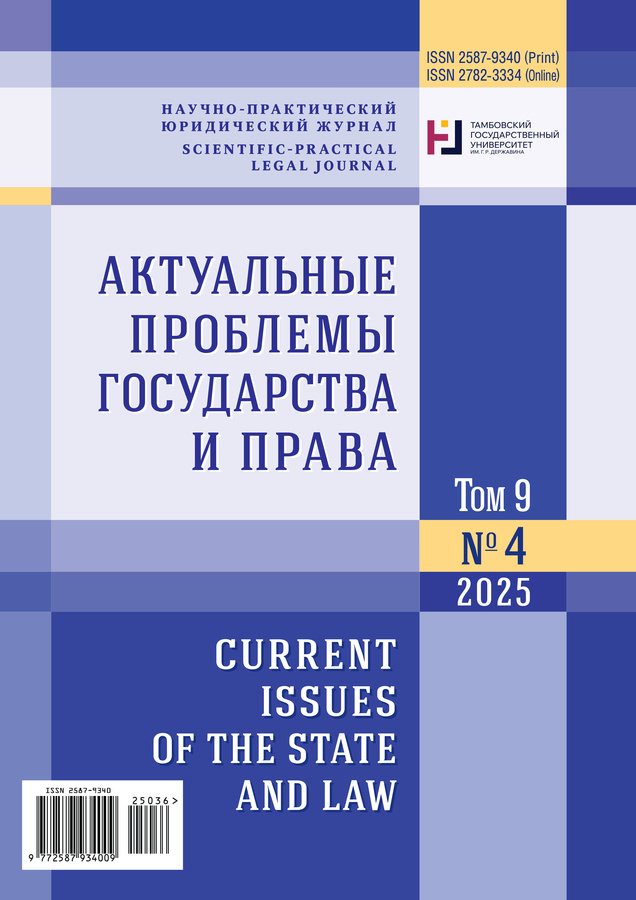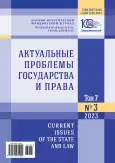Особенности криминалистической характеристики преступлений в сфере компьютерной информации
- Авторы: КИСЕЛЕВ А.С.1,2, ГОРБУНОВА К.А.1
-
Учреждения:
- ФГБОУ ВО «Государственный университет просвещения»
- ФГБОУ ВО «Финансовый университет при Правительстве Российской Федерации»
- Выпуск: Том 7, № 3 (2023)
- Страницы: 370-378
- Раздел: Общая теория и история права и государства
- URL: https://journal-vniispk.ru/2587-9340/article/view/303505
- ID: 303505
Цитировать
Полный текст
Аннотация
Цель работы состоит в выявлении основных особенностей криминалистической характеристики преступлений в сфере компьютерной информации, поскольку это имеет огромное значение в современном мире, так как компьютерные преступления становятся все более распространенными и угрожают безопасности информации, объектам критической инфраструктуры, личной жизни и финансов граждан, организаций и всего государства. Проанализирован терминологический аппарат, изучены классификации современных киберпреступников, определены основные подходы к совершению преступлений в сфере компьютерной информации. В исследовании были использованы следующие методы: анализ и синтез, индукция и дедукция, системный метод, диалектический и материалистический методы, формально-юридический метод. Изучение и анализ криминалистической характеристики позволяет определить наиболее распространенные способы совершения подобных преступлений, разработать эффективные меры противодействия. Установлено, что основной сложностью при расследовании данных преступлений является сложный технологический характер и порядок их совершения. Многие преступники постоянно совершенствуют свои навыки, наиболее квалифицированные из них стараются быть осторожными, разрабатывают собственные контрмеры против правоохранительных органов, используя шифры, специальные программы удаленного доступа, чтобы максимально затруднить как сбор доказательств, так и розыскные мероприятия. Помимо прочего, сложность привлечения киберпреступников осложняется в том случае, если злоумышленники находятся в другом государстве, а на международное сотрудничество в сфере правопорядка и общественной безопасности со многими западными странами на сегодняшний день, к сожалению, рассчитывать не приходится.
Об авторах
Александр Сергеевич КИСЕЛЕВ
ФГБОУ ВО «Государственный университет просвещения»; ФГБОУ ВО «Финансовый университет при Правительстве Российской Федерации»
Автор, ответственный за переписку.
Email: alskiselev@fa.ru
ORCID iD: 0000-0002-5044-4721
кандидат юридических наук, доцент кафедры гражданского права; старший научный сотрудник Центра исследований и экспертиз
Россия, Российская Федерация, 105005, г. Москва, ул. Радио, 10А; Российская Федерация, 125993, г. Москва, Ленинградский просп., 49Ксения Анатольевна ГОРБУНОВА
ФГБОУ ВО «Государственный университет просвещения»
Email: gorbynya.rambler.ru@yandex.ru
ORCID iD: 0009-0007-7475-6096
делопроизводитель кафедры предпринимательского права
Россия, Российская Федерация, 105005, г. Москва, ул. Радио, 10АСписок литературы
- Richet J.L. How Cybercriminal Communities Grow and Change: A study of communities Engaged in advertising fraud // Technological Forecasting and Social Change. 2022. Vol. 174. https://doi.org/10.1016/j.techfore.2021.121282
- Chang L.Y.C., Grabosky P. Cybercrime and Establishing a Secure Cyberworld // The Handbook of Security. L.: Palgrave Macmillan, 2014. P. 321-339. https://doi.org/10.1007/978-1-349-67284-4_15
- Ищенко Е.П. О технологии искусственного интеллекта в криминалистике // 30 лет юридической науки КубГАУ: сб. науч. трудов по материалам Всерос. науч.-практ. конф. с междунар. участием / под ред. В.Д. Зеленского. Краснодар: Кубан. гос. аграрный ун-т им. И.Т. Трубилина, 2021. С. 375-380. https://elibrary.ru/xgjggm
- Henthorne T. William Gibson: A Literary Companion. Jefferson: McFarland & Company, 2011. 176 р.
- Файзуллина А.А. К вопросу о соотношении понятий «криминалистическая характеристика преступлений» и «следственная ситуация» // Инновационная наука. 2017. № 2-2. С. 140-142. https://elibrary.ru/xvsiqn
- Григорян С.А. Особенности личности современного «киберпреступника» // Наука и образование: хозяйство и экономика; предпринимательство; право и управление. 2022. № 8 (147). С. 103-106. https://elibrary.ru/seyfyc
- Белевитина Ю.В. Криминологический портрет личности киберпреступника в современной России // Инновационная наука. 2022. № 12-2. С. 61-64. https://elibrary.ru/xcfqlv
- Мартынова Н.В. Некоторые аспекты криминологической характеристики личности киберпреступника // Студенческий вестник. 2022. № 17-5 (209). С. 7-10. https://elibrary.ru/jgqysk
- Сулейманов Р.Т., Атик Х.Б. Общая характеристика личности киберпреступника // Научный электронный журнал Меридиан. 2021. № 4 (57). С. 114-116. https://elibrary.ru/dbwcer
- Жижина М.В., Завьялова Д.В. Расследование преступлений в сфере компьютерной информации в Российской Федерации и зарубежных странах. М.: Проспект, 2023. 136 с. https://elibrary.ru/oimenm
- Попова С.В., Агафонова М.С., Машин А.А. Угрозы экономической безопасности в концепции войн шестого поколения // Цифровая и отраслевая экономика. 2020. № 4 (21). С. 55-63. https://elibrary.ru/seuuiy
- Могунова М.М. Технология осуществления и правовая регламентация незаконного овладения персональными банковскими данными (фишинг) // Вестник Саратовской государственной юридической академии. 2020. № 4 (135). С. 135-141. https://doi.org/10.24411/2227-7315-2020-10110, https://elibrary.ru/hfbjrg
- Вехов В.Б. Компьютерные преступления. Способы совершения, методики расследования. М.: Право и Закон, 1996. 182 с. https://elibrary.ru/yqclwu
- Клебанов Л.Р., Полубинская С.В. Компьютерные технологии в совершении преступлений диверсионной и террористической направленности // Вестник Российского университета дружбы народов. Серия: Юридические науки. 2020. Т. 24. № 3. С. 717-734. https://doi.org/10.22363/2313-2337-2020-24-3-717-734, https://elibrary.ru/isbbpl
- Поляков В.В. Обстановка совершения преступлений в сфере компьютерной информации как элемент криминалистической характеристики // Известия Алтайского государственного университета. 2013. № 2-1 (78). С. 114-116. https://elibrary.ru/rapmrx
Дополнительные файлы










